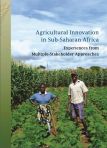By Sabine Homann-Kee Tui (ICRISAT, Bulawayo):
Part of the SLP team met in ICRISAT-Bulawayo from 28 November to 4 December to discuss research results and outputs of the crop residue project for the Southern African region. One of the main activities of the week were two workshops in Nkayi to review preliminary study results on the current state of crop livestock systems and crop residue utilization and discuss options with farmers and other stakeholders. The first workshop was held in one of the eight study villages, Sibangilizwe, where land use seemed the most intensive. Around 20 farmers of different ages, gender and herd sizes attended the meeting. The farmers first discussed the SLP survey results and then divided into two groups to discuss means to a) improve crop production and b) improve livestock production.
For crop improvement, access to improved seed and agricultural knowledge were emphasized. For livestock access to inputs and information on animal health and feed were of major concern. Exploring the option of improving cropping technologies to produce more and higher quality crop residues was viewed as an important solution to address livestock feed shortages. A final exercise clearly showed that farmers prefer to intensify the existing croplands and livestock above croplands and livestock expansion, take up new products for niche markets and commercialize, and move out of agriculture.
The following day, another workshop was hosted by local government (Rural District Council). Participants included farmers from a different village as well as from district and provincial level support services (Agricultural Extension Services, Department of Livestock Production and Development, Department of Veterinary Services, Department of Irrigation, Environmental Management Authority) and NGOs. A delegation, preparing a project proposal for submission to the Australian Centre for International Agricultural Research (ACIAR), also joined the meeting.
The participants discussed promising technical, institutional, policy options with regards to crop livestock intensification. Methods to improve soil fertility, crop diversification for food and feed and fodder crops were identified as important possibilities to explore. This needs to be supported by multidisciplinary teams that can capacitate service providers on supporting crop-livestock intensification and train farmers on the relevant technical issues. Local bylaws need to be strengthened for better use of cropland and rangeland. Crop and livestock markets should be resuscitated, sensitizing private sector about the existing market potential among smallholder farmers, improving linkages between input and output markets and knowledge on how farmers can make best use of these markets. Effective forms of facilitating communication among stakeholders, particularly research, extension and development, should be institutionalized for these purposes, with access to information highlighted as key requirement to enable farmers to embrace change.
The SLP team will use the experience (results and process tested) from the Nkayi workshops to inform the development of research tools across the SLP sites, especially to further study the institutional frameworks and options and for developing future research proposals.


